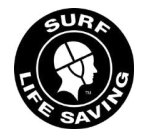(a) The event shall consist of four persons in each team – a Patient, Rescue Tube Swimmer and two Rescuers.
(b) Competitors in the Rescue Tube Rescue Race event shall assemble in the marshalling area. When entries have been checked, the Marshall shall notify each of the teams of their buoy number and colour.
(c) After marshalling, the Referee, Sectional Referee or their deputy (e.g. the Marshall or Announcer) shall give the command for the teams to file into the competition area and proceed to their allotted position on the start line facing the water.
(d) On the starting signal the patients enter the water and swim to their allotted buoy. On reaching their allotted buoy, the patient shall place their forearm over the top of the buoy and then signal their arrival by raising the other arm to a vertical position whilst remaining in contact with the buoy. The said signal, subject to all conditions being fulfilled, shall be the determining factor in judging the patients arrival at their buoy.
(e) The patient must then release contact with the swimming buoy and retire to the seaward side of the swimming buoy and await arrival of the rescue tube swimmer.
Note 1: Should a competitor swim to a wrong buoy and signal the team shall be disqualified.
Note 2: The swimming buoy is described as the buoy only and does not include any attaching ropes or straps.
(f) The rescue tube swimmer shall await the patient’s signal. The rescue tube swimmer will be in their allocated position on the shoreward side of the start line and may have their toes on or behind the start line.
(g) The rescue tube swimmer may wear the rescue tube neck strap (harness) and hold the rescue tube and swim fins in their hands or place them on the sand on the shoreward side of the start/finish line. The wearing of the swim fin/s prior to the starting signal is not permitted.
Note: The swim fins shall comply with the following dimensions:
- Maximum 65cm overall length including “shoe” or ankle strap (ankle strap extended).
- Maximum 30cm width at the widest point of the blade.
- Swim fins are to be measured with the shoe or ankle strap extended but not stretched. The swim fins will not be permitted to be used if they do not conform to specifications or if they are considered a safety hazard.
(h) On the patient’s arrival signal, the rescue tube swimmer crosses the start line, dons the rescue tube harness (if not already being worn) and swim fins at their own discretion and swims seaward to make the rescue of their patient. The Rescue Tube swimmer swims to the left hand side of the designated buoy (viewed from the beach) to the awaiting patient on the seaward side of the buoy.
Note: The team shall not be disqualified if the rescue tube swimmer crosses the start line and then resumes the correct position to correctly await the arrival signal from their patient.
(i) The rescue tube swimmer and/or the patient secures the rescue tube around the patient’s body and under both arms and clipped to an O-ring. The patient and rescue tube swimmer must remain behind the buoy line during the ‘clip in’ process. With the patient clipped into the rescue tube, the rescue tube swimmer continues (clockwise) around the buoy towing the patient back to the beach.
(j) The two rescuers must remain on the shoreward side of the start line until the tow has commenced. At their own discretion, they then may cross the start line and enter the water, and assist the rescue tube swimmer to bring the Patient back to the beach.
(k) The patient is permitted to assist by sculling with arms under the surface, of the water and kicking but must not swim with an out-of-water arm recovery. The patient must be towed on their back and the patient cannot be towed in any other way than clipped into the rescue tube.
(l) Only the rescue tube swimmer is permitted to use swim fins. Rescuers shall not use any equipment or swim fins they will simply assist with the rescue.
(m) On return to the beach the rescuers must drag or carry the
patient to the finish line. The finish is judged on the chest of the first team
member of the carrying party to cross the finish line denoted by two green or arena coloured finish
flags in an upright position on their feet (the rescue tube need not be
attached to the patient).
Note: While it is not necessary to drag the whole of the patient beyond the finish line teams are requested to immediately move to the shoreward side of the finish line to assist with judging of the event and to enable any trailing teams to finish.
(n) During the patient drag or carry to the finish, the patient may assist the carrying party by lifting their legs but shall not be permitted to assist the carrying party by standing unaided, walking or running to the finish line i.e. the patient cannot assist the carrying party by using their feet as a form of propulsion.
(o) Teams should continue to drag or carry the patient well past the finish line to assist with judging of other teams in the event.

